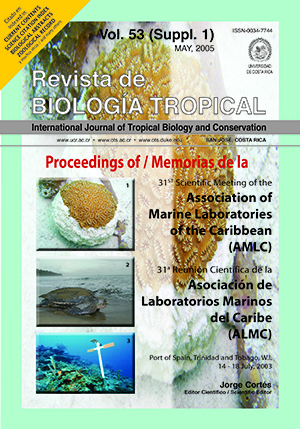Abstract
The Gulf of Paria is a semi-enclosed shallow basin with increasing coastal development activities along Trinidad’s west coast. Sediments present a host for trace metal pollutants from overlying waters, therefore determination of their content is critical in evaluating and detecting sources of marine pollution. This paper presents a Geographic Information System (GIS) analysis of geochemical assessment for trace metals in coastal sediments of the Gulf of Paria. This GIS approach facilitates interpretation of the spatial relationships among key environmental processes. The GIS development involves the integration of spatial and attribute data pertaining to bathymetry, current systems, topography, rivers, land use/land cover and coastal sediments. It employs spatial interpolation and retrieval operations to analyze the total trace metal concentrations of aluminum, copper and lead in the sediments and the clay-enriched sediments, to determine whether they are related to sediment type or are affected by the discharge from anthropogenic sources. Spatial distribution modeling of element concentrations are produced to indicate contamination plumes from possible anthropogenic sources such as rivers entering the Gulf of Paria, and to reveal potential hot spots and dispersion patterns. A direct spatial correlation between clay-enriched sediments and high concentrations of aluminum and lead is detected, however regions of high concentrations of copper and lead indicate a relationship to anthropogenic sources. The effectiveness of GIS for visualization, spatial query and overlay of geochemical analysis is demonstrated.References
Agard, J.B.R., M. Boodoosingh & J. Gobin. 1988. Petroleum residues in surficial sediments from the Gulf of Paria, Trinidad. Mar. Pollut. Bull. 19: 231-233.
Anonymous. 1999. Canadian Council of Ministers of the Environment. Canadian Sediment Quality Guidelines for the Protection of Aquatic Life: Summary Tables.
Bonham-Carter, G.F. 1994. Geographic Information Systems for Geoscientists: Modelling with GIS, Computer Methods in the Geosciences. Volume 13. Pergamon, Elseveir Science. Kidlington. 398 p.
Burrough, P. & R.A. McDonnell. 1997. Principles of Geographical Information Systems. Spatial Information System and Geostatistics Services. Oxford University, Oxford. 325 p.
Chang-Yen, I. & L. Hall. 1986. Metals in sediments off Trinidad, West Indies. Mar. Poll. Bull. 17: 274-276.
Cheng, Q. 1999. Spatial and scaling modeling for geochemistry anomaly separation. J. Geochem. Expl. 65: 175-194.
Erlenkeurser, H., E. Seuss & H. Willkomm. 1974. Industrial affects heavy metal and carbon isotope concentrations in Recent Baltic Sea sediments. Geochim. Cosmochim. Acta 38: 823-842.
Forstner, U. & G.T.W. Whittmann. 1979. Metal Pollution in the Aquatic Environment. Springer-Verlag, Berlin. 532 p.
Goncalves, M.A., A. Mateus & V. Olivera. 2001. Geochemical anomaly separation by multifractal modeling. J. Geochem. Expl. 72: 91-114.
Goodchild, M.F., B.O. Parks & L.T. Steyaert. 1992. Environmental Modeling: Process and Research Issues. Oxford University Press, New York. 486 p.
Harris, R.L., G.R. Helz & R.L. Cory. 1975. Processes affecting the vertical distribution of trace components in the Chesapeake Bay, p. 176-185. In T.M. Church (ed.). Marine Chemistry in the Coastal Environment. 169th Meet. Amer. Chem. Soc., Philadelphia, Penn., April 8-10, 1975, ACS Symp. Ser. 18.
Horne, R.A. 1969. Marine Chemistry the Structure of Water and the Chemistry Hydrosphere. Wiley, New York. 568 p.
Hu, J. 1995. Methods for generating surfaces in environmental GIS applications. Proc. 1995 ESRI Conf., Palm Springs, Calfornia, USA. May 22-26. 11 p. (Also available on-line: http://www/esri.com/library/ userconf/proc95/to100/p089.html)
Kelly, J., I. Thornton & P.R. Simpson. 1996. Urban geochemistry: A study of the influence of anthropogenic activity on the heavy metal content of soils in traditional industrial and non-industrial areas of Britain. Appl. Geochem. 11: 363-370.
Krauskopf, K.B. 1956. Factors controlling the concentrations of thirteen rare metals in sea-water Geochim. Cosmochim. Acta 9: 1-32.
Luoma, S.N. & G.W. Bryan. 1981. A statistical assessment of the form of trace metals in oxidized estuarine sediments employing chemical extractants. Sci. Total Environ. 17: 165-196.
Moussa, A.A. 1983. Trace elements in recent sediments of the delta continental shelf: Their accumulation and significance. 6th Workshop Pollut. Mediterranean. Cannes, 2-4 Dec. 1982. Pp. 101-104.
Naidu, A.S., A. Blanchand, J.J. Kellet, J.J. Goering, M.J. Hameedi & M. Caskaran. 1997. Heavy metals in Chukchi Sea sediments as compared to selected Circum- Arctic shelves. Mar. Pollut. Bull. 35: 260-269.
Nasr, S., M. El-Raey & A. Ibrahim. 1997. Geographic information system analysis for sediments, heavy metals and pesticides in Abu-Qir, Egypt. J. Coast. Res. 13: 1233-1237.
Presley, B.J. 1997. A review of arctic trace metal data with implications for biological effects. Mar. Pollut. Bull. 35: 226-234.
Rees, J. & M. Williams. 1996. The land and ocean contamination study. Earthwise, Brit. Geol. Surv. 9: 12-14.
Ridgway, J. & P. Stevenson. 1996. Evaluation of contamination in estuarine and coastal sediments. Earthwise, British Geol. 9: 10.
Schmidt, H. & C.E. Reimers. 1991. The recent history of trace metal accumulation in the Santa Barbara Basin Southern California Borderland. Estuar. Coast. Shelf Sci. 33: 485-500.
Selinus, O.S. & K. Esbensen. 1995. Separating anthropogenic from natural anomalies in environment geochemistry. J. Geochem. Expl. 55: 55-60.
Shepherd, F.P. 1954. Nomenclature based on sand-silt-clay ratios. J. Sed. Petrol. 24: 151-158.
Szefer, P., A. Kusak, K. Szefer, H. Jankowska, M. Wolowicz & A.A. Ali. 1995. Distribution of selected metals in sediment cores of Puck Bay, Baltic Sea. Mar. Pollut. Bull. 30: 615-618.
Troup, B.N. & O.P. Bricker. 1975. Processes affecting the transport of materials from continents to oceans, p. 133-151. In T.M. Church (ed.). Marine Chemistry in the Coastal Environment. 169th Meet. Amer. Chem. Soc., Philadelphia, Penn., April 8-10, ACS Symp. Ser. 18.
Zhang, C. & O. Selinus. 1998. Statistics and GIS in environmental geochemistry – some problems and solutions. J. Geochem. Explor. 64: 339-354.
Zhang, C. & L. Wang. 2001. Multi-element geochemistry of sediments from the Pearl River system, China. Appl. Geochem. 16: 1251-1259.
Zhang, C., O. Selinus & G. Kjellstrom. 1999. Discrimination between natural background and anthropogenic pollution. Sci. Total Environ. 243/244: 129-140.
##plugins.facebook.comentarios##

This work is licensed under a Creative Commons Attribution 4.0 International License.
Copyright (c) 2005 Revista de Biología Tropical






